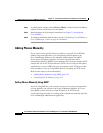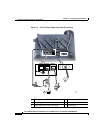
Chapter 3 Installing the Cisco IP Phone
Before You Begin
3-2
Cisco IP Phone Administration Guide for Cisco CallManager 3.2, Cisco IP Phones 7960/7940/7910
78-10453-04
Before installing the Cisco IP Phone, review the requirements in these sections:
• Network Requirements, page 3-2
• Cisco CallManager Configuration, page 3-2
• Safety, page 3-3
Network Requirements
For the Cisco IP Phone to successfully operate as a Cisco IP Phone endpoint in
your network, your network must meet the following requirements:
• Working VoIP Network
–
Voice over IP (VoIP) configured on your Cisco routers and gateways
–
Cisco CallManager Release 3.0 or higher installed in your network and
configured to handle call processing
• IP network that supports DHCP or manual assignment of IP address, gateway,
and subnet mask
Cisco CallManager Configuration
The Cisco IP Phone requires Cisco CallManager to handle call processing. Refer
to the Cisco CallManager Administration Guide or context-sensitive help in the
Cisco CallManager application to ensure that Cisco CallManager is set up
properly to manage the phone and to properly route and process calls.
If you plan to use auto-registration, verify that it is enabled and properly
configured in Cisco CallManager before connecting any Cisco IP Phone to the
network. See the “Using Auto-Registration” section on page 2-11 for details.
In Cisco CallManager, you can add users to the database and associate them with
specific phones. By doing this, users gain access to web pages that allow them to
configure phone options such as call forwarding, speed dialing, and voice mail.
See the “Adding Users to Cisco CallManager” section on page 6-5 for details.


















